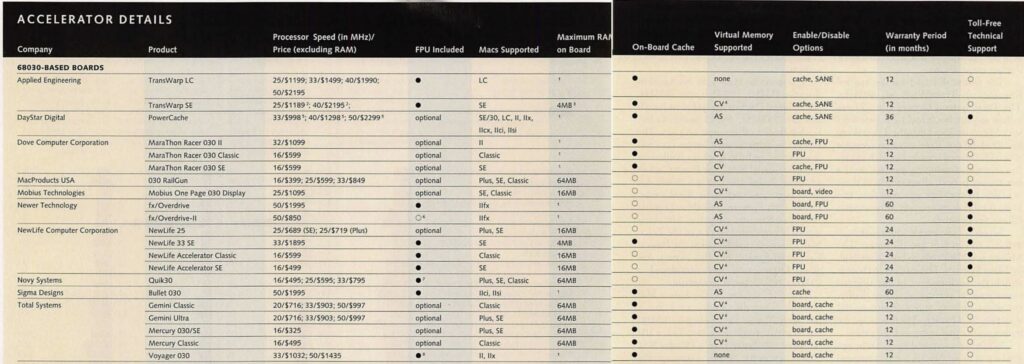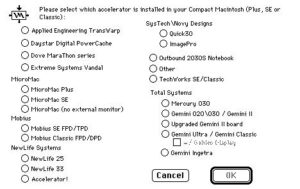Last updated on September 14, 2025
Connectix Virtual was initially created by Jonathan Garber to provide virtual memory on Macintosh systems by using swap files on their hard drives as “virtual memory”. Later versions of the software became the standard means of accessing RAM past 4MB on Macintosh systems with 68020 (with PMMU) and 68030 (not 68EC030) accelerators installed that also added additional memory to the host systems. I decided to create this page as a companion to my list of accelerators.
Connectix Compact Virtual vs. Connectix Virtual
As part of putting together this page I learned there are 2 versions of Virtual 3.0. One for Mac Plus, SE and Classic systems called Compact Virtual, and one called Virtual for the Mac II with a PMMU, accelerated LCs, and all other Macintosh systems shipped with 68030 processors.
Compact Virtual, also enables accelerated Mac Plus, SE, and Classic systems to address two and four megabyte SIMMs installed on compatible accelerator boards. This makes it possible for the first time to use up to 16MB of physical RAM on one of these systems as application memory. Since these systems are not able to use 32-bit addressing, Compact Virtual is the only way to address large amounts of physical RAM or virtual memory.
A different version of this product, Virtual 3.0, is available for use on Macintoshes based on the 68030 processor, Mac II with a PMMU, or accelerated LC.
From the Compact Virtual 3.0 users manual
Downloads and partial list of supported accelerators
I’ve listed what I’ve found so far, if anyone has other versions please let me know in the comments section.
Notes:
- Make sure that your accelerator has a full 68030 (not 68EC030) CPU or a 68020 CPU and a 68851 PMMU. The 68EC030 processors do not contain PMMU circuitry and, even with Compact Virtual, you will he unable to access virtual memory. (from Compact Virtual 3.0 Quick Reference)
- Compact Virtual 3.0 only supports accelerated machines having real RAM configurations of at least 4 MB (see RC4 readme). Not clear if this means 4MB total, or there must be 4MB on the motherboard. Also not clear if this is required for 3.0.2.
| Compact Virtual 3.0.2 | MG, MR, MGUI | Readme for System 7.1.x or earlier (NOT 7.5.x) |
| Compact Virtual 3.0 RC4 | MG | Readme RC4, Manual, Quick Reference |
| Virtual 3.0.1 | MG, VA | Readme |
| Virtual ‘030 v2.04 | MG, MGUI, VA | Manual |
| AppleShare 3.6.1 Patch | MGUI | Readme, for Virtual + System 7.5.1 |
| AT-Patch | MG | Readme, for Compact Virtual |

In addition to Compact Virtual and Virtual, Connectix also published Connectix Maxima that allowed users to access up to 14MB of RAM (instead of 8MB) in 24-bit addressing mode, with the RAM above 14MB usable as a RAM disk. There is also Connectix Optima that enables 32-bit mode for System 6.x.
Replacement
In 1994 Connectix released RAM Doubler which appears to partially replace Virtual for the Mac II and LC systems. It does NOT replace Compact Virtual for accelerated compact systems.
RAM Doubler can work on the original Macintosh LC if it has a Daystar, Diimo, or Dove accelerator installed.
RAM Doubler can work on the original Mac II, if the 68851 PMMU chip is installed, or if a 68030 or 68040 accelerator is installed.RAM Doubler will NOT work with:
From the RAM Doubler v1.0 manua
- Mac Plus or earlier, Mac SE, Mac Classic or Mac LC, PowerBook 100 or Apple Portable (use Compact Virtual instead)
- almost any Applied Engineering TransWarp accelerator
- any TokaMac accelerator or any Mobius accelerator
- the Radius Rocket when used as the main CPU
- The basic test is: Will the accelerator work with System 7 Virtual Memory? If it will, it is compatible with RAM Doubler. If not, it may not be compatiable.
Performance
When I did some tests on my SE, with my Mobius 030 accelerator installed, I noticed that the memory speed dropped significantly in benchmarks when I enabled Compact Virtual. Recently I found a note in the manual for the Extreme Systems Vandal accelerator saying the speed is expected to be slower than the onboard RAM, but still a lot faster than using a hard disk for virtual memory. I will need to do further testing with other accelerators with onboard RAM that use Compact Virtual.
Virtual memory increases the amount of RAM available for the MC68030 microprocessor to use. The SE cannot utilize System 7’s built-in virtual memory feature. However, you can put up to 16MB of RAM on the VANDAL accelerator, using Compact Virtual™ from Connectix to address the RAM above the 4 MB limit of the SE. Virtual memory assigned to a hard disk, such as System 7’s built in virtual capability, is very slow. Virtual memory assigned to RAM is not as fast as physical, directly accessed RAM, but it is many times faster than virtual memory assigned to a hard disk.
Extreme Systems Vandal Users Guide Section 6: Using Compact Virtual
History
While creating a laboratory control system on his Macintosh II in 1988, Jonathan Garber found the computer needed more random access memory, or RAM, to run his programs. But at about $400 a megabyte, the RAM he needed would have cost him more than $1,000.
He knew that large computers running on the Unix operating system were capable of freeing up RAM space by temporarily stashing chunks of RAM data on a disk drive. After tinkering with his Mac II’s operating system, he was convinced he could use the memory-swapping techniques to trick its CPU into acting as if it had far more RAM than it actually did.
He originally contacted Apple with his idea, and the company offered him $50,000 and a job. He turned them down, adn then spent three weeks developing the initial version by himself. With his software and Motorola’s memory management chip, the new software effectively doubled his Mac II’s RAM. Then he set out to determine just how much his idea would be worth to the rest of the world.
He and his then girlfriend (now wife), Bonnie Fought, raised $50,000 in startup capital from friends and relatives and make copies of the program on floppy disks to sell at the Macworld Expo trade show in San Francisco.
In four days, they sold 300 copies of the program, named Virtual, for $500 each (including the $250 chip), grossing $150,000. “We could not make the disks fast enough,” Garber remembers.
Additional details about Jonathan Garber life and the history of Connectix can be found in the Forbes article: Real men write assembly code
References
- Website: www.connectix.com (starting from 1997.12). I wasn’t able to find any information on the cached website for Compact Virtual, other than it being mentioned on the company’s About page “Connectix has a history of building innovative products for the Macintosh platform. Virtual (1988) was the first and fastest virtual memory utility for the Mac operating system“, and their Awards page: “Virtual was a technological breakthrough which allowed Virtual Memory to be run on a personal computer – years before Apple Computer or Microsoft could incorporate it into their operating systems. It ran on the Mac II with System 6.0.5 and higher”
- 1989.01 MacWEEK Vol 09 Num 02: Virtual memory ends RAM jam. The 8 month-old Menlo Park, Calif., company, headed by Jonathan Garber, programmer-president, will begin shipping Virtual at Macworld Expo next week.
- 1992.06 MacWorld: Lab Notes, and a Need for Speed, a review of accelerators that includes a list of which accelerators use Compact Virtual to access more than 4MB of ram. “To break the 4MB limit of the 68000 based machines — the Plus, the SE, and the Classic — some accelerator vendors are shipping their compact Mac 030 accelerator boards with Connectix’s Compact Virtual. If you need to access more than 4MB of RAM on a 68000-based compact Mac, get an accelerator board that supports Compact Virtual 3.0“
- 1992.12 TIL10981: System 7 Compact Virtual 3.0 and the TransWarp Accelerator Board
- 1993.01 TidBITS: Virtural 3.0
- 1993.06 MacWorld: Upgrading your Mac, and Expanding a Compact Mac, discusses using Compact Virtual 3.0 with accelerator boards.
- 1993.06.14 MacWEEK Vol 07 Num 24. An Advertisement for Compact Virtual 3.02
- 1993.08 MacUser UK: Letters, mention of Compact Virtual 3.2, I assume them mean 3.02
- 1994.06 MacWorld: Virtual Memory Realities, benchmarks of System 7’s virtual memory vs. Compact Virtual 3.0
- 1997.01 Forbes Magazine: Real men write assembly code. Background on the creation of the first version of Virtual. “Garber knew that large computers running on the Unix operating system were capable of freeing up RAM space by temporarily stashing chunks of RAM data on a disk drive. After tinkering with his Mac II’s operating system, Garber was convinced he could use the memory-swapping techniques to trick its CPU into acting as if it had far more RAM than it actually did.”
- 1997.07 MacUser: Never Say Die, one of the final articles I’ve found talking about accelerators for compact macs. Mentions Compact Virtual but not the version.
